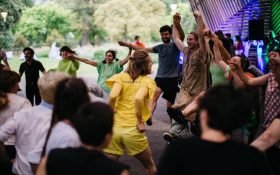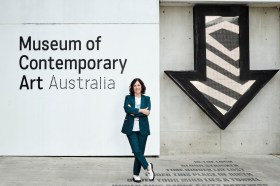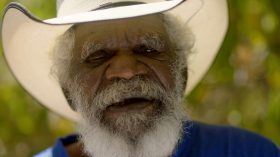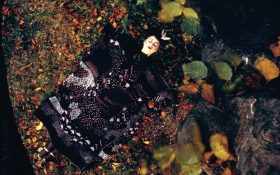Stephen Farthing, No Towers (Sth Manhattan) No.3 (2001). Image courtesy of the artist.
As residents of the Asia Pacific region, we live in a time where global environmental uncertainty sits alongside local concerns of political, colonial and immigrant histories of trauma and crisis. Of late, the Asia Pacific region has been struck by many natural disasters, including the post-typhoon wreckage of Daiichi (the Fukushima nuclear power plant) in 2011, Typhoon Haiyan in the Philippines in 2013, and flash flooding in the Solomon Islands.
Linden’s latest exhibition, ‘Witness’, invites artists to respond to disaster, trauma and crisis in their work. This brief interrogates how we, as an implicit part of an informal network of international voyeurs, react to, filter, and otherwise process startling information that is readily available in news articles, social media updates, forums, and live-streaming content.
In the front space, Jeremy Wafer’s Compound (2014), a varnished pencil wall drawing (rendered in a meticulous manner similar to Sol Lewitt’s instructional pieces) offers a two-point perspective view of a row of utilitarian jail cells. Sitting nearby is Eduardo Kairuz’s museum-style horizontal display case of minutely cut-out images of what is unmistakably high-rise housing units, pierced with pins in a style similar to a butterfly collector preserving a prized specimen. These works subtly elicit questions about the amount of space a single person requires in order to stay alive or lead a comfortable life. The nature of compartmentalised living is a reality for many – particularly in the wake of natural and man-made disasters.
The small space of the following room pushes you close to Professor Stephen Farthing’s No Towers (Sth Manhattan) No.3 (2001) and No Towers (Sth Manhattan) No.1 (2001). Painting a portrait of the slow unfolding of communal mourning and memorialization, the subject is the absence of the twin towers: grey silhouettes of contemplative pedestrians pass two blue, bottomless pits.
In the subsequent space, Si Sapsford, John Vella, and Kit Wise consider the domestic, bureaucratic, or abruptly disturbing negotiations that people individually navigate as they witness or experience collective trauma. Their artworks act as reminders of the daily human actions in the home, office, or school that occur concurrently with crisis.
A toungue-in-cheek take on the dexterity and effort needed to navigate a bureaucratic system in a time of crisis, John Vella’s Proxy (2014) involves five archival inkjet prints on A3 sheets of paper displaying all the hallmarks of a governmental form, only with blank lines instead of detailed questions, fixed to the wall by indoor rock-climbing appendages.
Slipping on the headphones, we are struck by Kit Wise’s Choir (After Tohoku) (2014) that documents a Japanese-speaking man negotiating the tsunami, in real time – with flashes of colour on-screen and excruciating recorded snippets.
In the next room, three black coffin-like benches house a different category: Poland, Buchenwald Boys, and Budapest. Kathy Temin’s gathered and edited spoken material, accrued after years of exploring her own identity, is here for the listening. The rhythm of the voices as they tell stories about their life allows encourages the visitor to slow down, and take a moment.
The exhibition builds on an international symposium, held in June 2012 at Monash University Museum of Art (MUMA) in partnership with Monash Art Design and Architecture (MADA). When hyperbole and attention-seeking is the norm in the media (and often the gallery) this exhibition is a refreshingly pared-back examination of our times.
Rating: 4 ½ out of 5 stars
Witness
Artists: Brook Andrew, Lucy Bleach, Prof. Stephen Farthing, Eduardo Kairuz, Tom Nicholson, Si Sapsford, Kathy Temin, John Vella, Prof. Jeremy Wafer, Kit Wise. Curated by Kit Wise.
Linden Centre for Contemporary Arts, Acland St, St Kilda
www.lindenarts.org
4 April – 11 May





